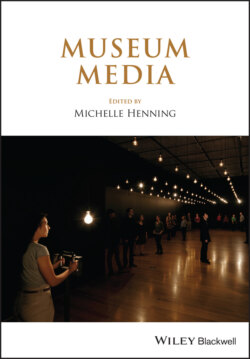Читать книгу Museum Media - Группа авторов - Страница 30
Notes
Оглавление1 1 “We all live in an information age – or so we tell each other as we caress our smart phones like rosary beads, heads down, checking, monitoring, tweeting. We’re wired; we’re on message; and the dominant theme of the message is ourselves. Identity is the zeitgeist. A lifetime ago in ‘Brave New World,’ Aldous Huxley predicted this as the ultimate means of social control because it was voluntary, addictive and shrouded in illusions of personal freedom” (Pilger 2014).
2 2 In his introduction to the 1964 edition of Innis’s book The Bias of Communication (originally published in 1951), McLuhan wrote: “I am pleased to think of my own book The Gutenberg Galaxy as a footnote to the observations of Innis on the subject of the psychic and social consequences, first of writing then of printing” (McLuhan 2005, 8).
3 3 In his essay “The Bias of Communication” Innis argued that different historical technologies of communication (stone and hieroglyphics; clay and cuneiform script; papyrus and alphabet; paper and printed gothic script) favored or hindered different kinds of social organization – from centralized absolute monarchies to oligarchies, to complexly administered empires. In Innis’s terms, radio itself already carries a specific and undemocratic bias toward “centralization” and “a concern with continuity” (Innis [1951] 2008, 33).
4 4 The research conducted by Karin Harrasser and her colleagues makes use of Stuart Hall’s semiotic encoding–decoding model, but while Hall tended to view oppositional, or resistant, readings as empowering, Harrasser found that the process of negotiating such readings can actually be stressful and difficult (Harrasser, Chapter 17).
5 5 “Whether the light is being used for brain surgery or night baseball is a matter of indifference. It could be argued that these activities are in some way the ‘content’ of the electric light, since they could not exist without the electric light. This fact merely underlines the point that ‘the medium is the message’ because it is the medium that shapes and controls the scale and form of human association and action. The content or uses of such media are as diverse as they are ineffectual in shaping the form of human association” (McLuhan [1964] 2001, 23–24).
6 6 See http://www.hauserwirthsomerset.com/about (accessed September 2, 2014).
7 7 Like the natural history dioramas in the American Museum of Natural History New York, it raises interesting questions about how an exhibition design can itself become an artifact, worthy of conservation. To recognize the dioramas as aesthetic objects worth preserving means acknowledging a change in function: these are no longer just preserved moments and spaces from nature, intended to educate and inspire visitors about the natural world; they are also time capsules of exhibition design, a specific moment in the history of the craft.
8 8 Visitors are asked “to inhabit, for the duration of the game, a real environment. The meaning of an Exhibit is now dependent on the decisions of the visitors, just as, at an earlier stage, it was dependent on the artists who were the players. It is a game, a maze, a ceremony completed by the participation of the visitors. Which routes will they take, will they move through narrow or wide spaces, where will they decide to stop and assess the whole” (poster for an Exhibit, displayed at the ICA, February 2014; emphasis original).
9 9 These are concerns heightened by early twenty-first-century scandals regarding data-gathering by both commercial organizations and security and surveillance agencies such as the National Security Agency (NSA) in the United States, and Government Communications Headquarters (GCHQ) in the United Kingdom.
10 10 This international declaration can be found at http://www.mediaarthistory.org/declaration (accessed July 17, 2014).
